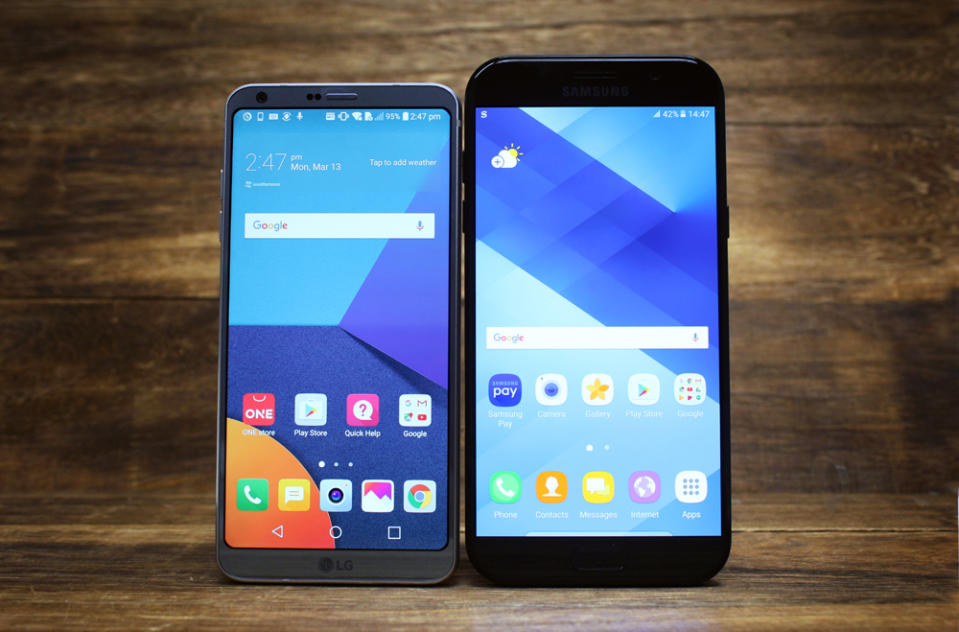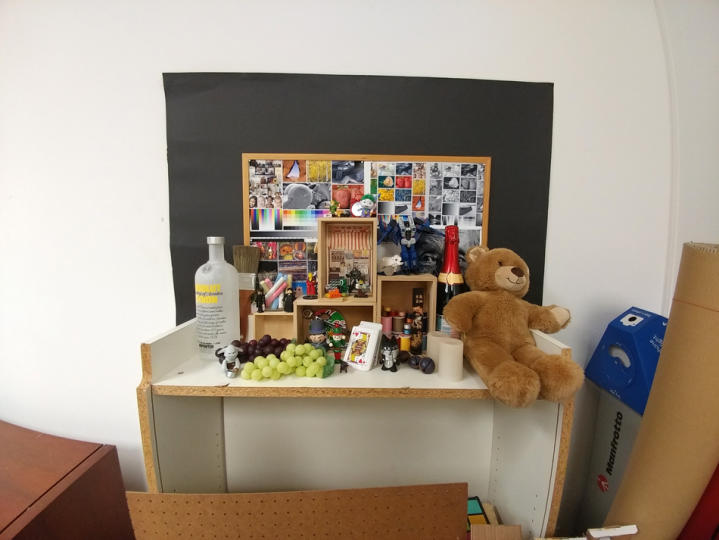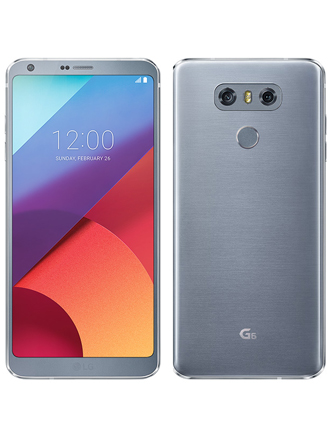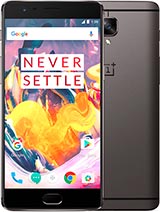LG G6 review: Can LG's bezel-less competitor challenge the Samsung Galaxy S8?
Overview
Everyone want larger displays, but no-one wants the extra bulk that goes with them. Enter: the LG G6 (and also the Samsung Galaxy S8 and S8+), which packs a huge 5.7-inch display into a body that's smaller than last year's 5.3-inch G5. LG has done this by stretching the display out, giving it an 18:9 aspect ratio, and eliminating wasted space at the top and bottom. The end result is a gorgeous, modern-looking phone.
But is it enough to carry LG to the top of the flagship smartphone market? Let's find out.
| |
| |
| |
| |
| |
| |
| |
| |
| |
| |
| |
|
Design
The first thing you'll notice about the G6 is its massive display. The 5.7-inch display has a stretched 18:9 aspect ratio, which makes it taller and thinner than the 16:9 aspect ratio displays found on most other phones, but also keeps the G6 compact and easy to use one-handed. Samsung's S8 and S8+ use a very similar 18.5:9 aspect ratio.

Design-wise, the G6 is fairly blocky, with a slab-like form factor that makes the phone feel a lot chunkier than Samsung's S8. The G6 is actually 0.1mm thinner than the S8, but it feels thicker due to the S8's tapered edges. In terms of overall size, the G6 is quite similar in size to last year's G5 (it's actually slightly shorter and narrower, but 0.2mm thicker).
The rear of the phone has a Gorilla Glass 5 panel which is slightly curved at the edges. Interestingly, the front panel is only Gorilla Glass 3, which might make it slightly more susceptible to breaking than the rear (if an unfortunate mishandling incident occurs). As is generally the case with glass-rear phones, the back of the G6 is a bit of a fingerprint magnet and more-so if you choose a darker colored model.
This is also the first LG phone in a long time that hasn't had a removable rear (or in the case of the G5 a removable bottom). That means the battery can't be removed or replaced. On the plus side, it also means LG has been able to make the G6 IP68 certified, which means it can withstand up to 1.5 meters of water submersion for up to 30 minutes at a time. So weathering the elements is finally a feature on LG's flagship phone.

The one-piece aluminum frame that runs around the edge of the phone houses the antennas and makes the phone feel solid and rigid. The edges of the frame are chamfered, which is a style that's looking a bit dated now, and clashes with the otherwise modern-looking design of the huge display.

On the rear, there's a fingerprint sensor that doubles up as a power button (similar to how the G5, V10 and V20 handle) below the dual-lens camera module. Notably improved is that both the fingerprint scanner and camera module are now completely flush with the surface of the phone.
The volume buttons can be found on the left side, with the dual nano-SIM card tray on the right. The second SIM slot doubles up as a microSD card slot that is compatible with cards up to 256GB in capacity. Internally, you get 64GB storage.

On the bottom of the phone is a USB Type-C port and a single downward-firing speaker.

And on top, there's a standard 3.5mm headphone jack.

Our review model is the gorgeous platinum color, but the G6 is also available in black and white.

Display
The G6's 5.7-inch QHD display has a 2,880 × 1,440 pixels resolution (564ppi) with an 18:9 ratio. This equates to 2:1, which means two perfect squares fit next to each other on it, something LG takes advantage of in its software features (more on this on the next page).
It's worth noting that, like the Samsung S8, the unusual aspect ratio means that the 5.7-inch display isn't actually as large as a traditional 5.7-inch display with a 16:9 ratio. In fact, if you open a website and put the G6 side-by-side with a 5.5-inch iPhone 7 Plus, the iPhone 7 Plus will display more text than the G6 - of course, the iPhone 7 also has a much larger form factor. Speaking of the Apple iPhone 7 Plus and the LG G6, we asked some non-editorial colleagues which phone has a bigger display just from a visual perspective. Check out what they have to say:
Measuring the dimensions of the G6's display confirms this: its 130 x 65mm screen results in a total screen area of 845mm² (which, interestingly, is exactly the same screen area as Samsung's 5.8-inch 18.5:9 S8), whereas the Samsung Galaxy A7 (2017), which has a traditional 16:9 5.7-inch display, has dimensions of 126 x 71mm, resulting in a larger screen size of 894.6mm² (check the below image). It's still a big screen experience, just not as big as you may have anticipated based on that "5.7-inch" spec.

As with the S8, the unusual screen ratio also poses a problem with app and content compatibility. Most apps and the majority of content is made for 16:9 ratio, so you often have to deal with content that is either cropped at the sides, or has black bars at the edges. Most games in particular, play with black bars at the side, so you don't get to use all of the G6's screen space.
There is some 21:9 content out there that looks fantastic on the G6, but even that isn't perfect, with black boxes at the top and bottom. This problem may only be temporary anyway, as Google has recently started encouraging developers to support a widescreen aspect ratio on their apps.
One of the things that differentiates LG and Samsung's displays is the HDR format each supports. Samsung is Mobile HDR Premium-certified, while LG is currently the only phone supporting Dolby's enhanced Dolby Vision HDR, as well as the older HDR 10 format. Dolby says that its HDR gives even better color reproduction due to using frame-by-frame metadata to ensure that the display is always showing you the best results. It's compatible with all of the mobile HDR content on Netflix and Amazon Prime, but you won't see any benefit from regular non-certified content.

The display itself is excellent, with vivid colors and crisp text. Contrast isn't quite as good as the Super AMOLED panel used on the S8, but it's still fairly good, and one of the better LCD panels I've seen. Additionally, while the G5's display was a little dim, the G6 is much brighter, going up to 600 nits when you're in auto brightness mode and in bright lighting (like direct sunlight). It's worth noting that manually adjusting the screen brightness won't let you go quite as bright. Like last year's G5, it's an always-on display, which means you'll be able to see the time, your remaining battery life, and any notifications, whenever the home screen is off. You can read more about it from our older G5 review as it's mostly similar. This convenience does come at the cost of slightly reduced battery life, but you can always turn it off.
Audio
LG is one of the few brands that really focuses on audio quality. We saw this with the V20 with its excellent Sabre ES9218 Quad DAC, and thankfully, LG is once again using a Sabre 32-bit Quad DAC in the G6. This time, it's the Sabre ES9218+ variant. Like the original ES9218, this DAC also features a parallel sub-DAC configuration to improve noise performance and reduce total harmonic distortion.

Despite using variants of the same Sabre DAC there were some slight but noticeable differences between the G6 and V20. Overall sound quality is very good on both models, with a wide sound stage and clean separation between instruments and vocals. The V20's bass is noticeably stronger though, while the G6 has more emphasis on the highs. I tested both models using the same Audio-Technica ATH-M50s headphones using 24-bit FLAC files. Like the V20, the G6 supports nearly every file format out there, including ultra high-end DSD512 32-bit files.
It's worth noting that while the G6 supports audio through both the 3.5mm jack and the phone's USB Type-C connection, the Quad DAC is only compatible with the 3.5mm connection. If you have a pair of USB Type-C headphones, or you're using wireless Bluetooth headphones, your audio quality will depend entirely on the quality of the DAC inside those devices.
Like the V20, the G6 can also record high-end 24-bit, 192kHz FLAC audio through LG's HD Recorder app. Note though that it only has two Acoustic Overload Point microphones compared to the V20's three, which means it's not as good at positional audio. Nevertheless, it's still pretty good and the app offers an abundance of configurable options for music and instrumental recordings.

As for the phone's own speaker, LG hasn't paid it nearly as much attention, with the G6 sporting just a single downward-firing unit at the bottom of the phone. It's actually not too bad, with a reasonable amount of volume and decent bass, but you're still much better off plugging in pretty much any pair of headphones.
Software features
The G6 runs on Android 7.0 Nougat with LG's UX 6.0 UI installed on top of it. Compared to stock Android, LG hasn't changed too much, with some minor tweaks to the notification shade, and Settings menu, and there's also an option to disable the app tray and spread apps across multiple home screens instead, similar to what Xiaomi, Huawei and many other Chinese smartphone brands do.

You can also get theme packs to match the color scheme of your G6 with backgrounds, wallpapers, and icons from the LG SmartWorld app.

LG has also included some of its own features in UX 6.0. Multi window makes good use of the G6's 18:9 ratio screen for multi-tasking by letting you view two apps side-by-side, each in its own perfect square. Just activate it by long pressing the Android Menu key and selecting the apps you want to view. Having said that, a disappointingly large number of apps, including many of LG's own, did not work with Multi window.


LG also pre-installs quite a few of its own apps, most of which we've seen in previous LG phones, including its own Image Gallery app, LG Health, a File Manager, Calendar app, Music app, and an FM radio app (yes it still supports traditional FM radio functionality). For the most part you're better off just continuing to use Google's version (or your own preferred alternative), although one advantage of LG's version is that most of their apps make use of the 18:9 aspect ratio, and fill up the whole display.
The G6 is also one of the first smartphones (other than Google's own Pixel phones) to support Google Assistant. Long press on the home button bring it up.
Performance Benchmarks
Rather than wait for Qualcomm's new flagship Snapdragon 835 processor, LG has opted for last year's Snapdragon 821 which is now more than seven-months-old. The 821 still has plenty of power, just be aware that at this time it's no longer considered flagship-level. Part of the problem is that Samsung has secured the bulk of the first shipment of Snapdragon 835 processors, leading to a shortage for other manufacturers. How much will this setback LG? Let's find out.
|
|
|
|
|
| |
|
| — |
|
|
| |
|
|
|
|
|
| |
|
|
|
|
|
| |
|
|
|
|
|
| |
|
|
|
|
|
| |
|
|
|
|
|
| |
|
|
|
|
|
| |
|
|
|
|
|
| |
|
|
|
|
|
| |
|
|
|
|
|
| |
|
|
|
|
|
|
Sunspider Javascript
SunSpider JavaScript measures the browsing performance of a device when processing JavaScript. It not only takes into consideration the underlying hardware performance, but also assesses how optimized a particular platform is at delivering a high-speed web browsing experience.
The G6 was a bit faster than last year's models, but was slightly slower than the OnePlus 3T. The Samsung Galaxy S8 and Apple iPhone 7 were much, much faster.

Quadrant
Quadrant is an Android benchmark that evaluates a device's CPU, memory, I/O and 3D graphics performances. The G6 scored quite a bit better than the V20 and G5, but was still beaten by the OnePlus 3T. The Samsung S8 was once again much better.

3DMark Sling Shot
3DMark Sling Shot is an advanced 3D graphics benchmark that tests the full range of OpenGL ES 3.1 and ES 3.0 API features including multiple render targets, instanced rendering, uniform buffers and transform feedback. The test also includes impressive volumetric lighting and post-processing effects. We're running this benchmark in Unlimited mode, which ignores screen resolutions.
Once again we saw some small improvements over the G5 and V20, with the G6 still lagging behind the OnePlus 3T. The S8 and iPhone 7 are still miles ahead.
Imaging
The dual camera setup from the LG G5 and V20 returns on the G6, with just a few minor tweaks. First of all, both normal and wide-angle camera lens are the same 13-megapixels, which means there'll be less of a drop in quality when switching between the normal and wide angle lenses. Having said that, the main camera is still better, thanks to its optical image stabilization and faster f/1.8 aperture. The wide-angle lens still lacks OIS and is hampered by a pretty slow f/2.4 aperture, which often results in less sharp images, especially in weak light. As a result, you're better off using the main camera whenever possible.
Image quality on the G6 is quite good, but hasn't improved much, if at all, on last year's G5 and V20. The main camera is still better, with good detail and natural color reproduction, although there is some softness towards the edges of the frame. The wide-angle lens still struggles in low-light and has some fisheye distortion, though it has improved in this aspect from the G5.



To take advantage of the 18:9 aspect ratio, LG has also included an interesting Square Camera feature, which you can access through the settings menu in the main camera app, or through its own dedicated Square Camera app shortcut. Square Camera splits the screen in two, with the top half for square format pictures and the lower half for previews, or custom shots. Inside Square Camera there's also a fun Grid Shot mode, which breaks the bottom square down further into quarters, each filled with a still image or a three-second video clip, which you can use to tell a short story. There’s plenty of room for creativity, and best of all, the result can easily be shared on Facebook or Twitter, with videos intact.
Other features in Square Camera include Match Shot, which is like Grid Shot but with two pictures instead of four, and Guide Shot for matching photos using a handy transparent overlay, so people can capture the same pose or composition on multiple occasions.
Battery Life
Our standard battery test for mobile phones has the following parameters:
Looping a 720p video with screen brightness and volume at 100%
Wi-Fi and Bluetooth connectivity turned on
Constant data streaming through email and Twitter
Unlike the G5 and V20, the G6 has a non-removable battery, but to compensate, it has also increased in capacity to 3,300mAh. Unfortunately that didn't make much difference and the G6 still under-performed in our battery life benchmark, lasting just seven hours and 42 minutes, almost half the battery life of the similarly Snapdragon 821-powered OnePlus 3T. In day-to-day usage I also noticed the G6 running low on battery towards the end of the day. If you choose to use the always-on-display feature, it will drain the battery even faster.
There's no wireless charging on the G6, but it does support Qualcomm's Quick Charge 3.0, which gets it back to around 60 percent charge in just 30 minutes.

Conclusion

After tinkering for years with gimmicky features like curved form factors, rear buttons, and modular designs, the LG G6 seems downright minimalist in comparison. But sometimes simple designs work best and the G6's attractive metal and glass build and huge display work really well.
Unfortunately, despite being unveiled a month earlier, a big part of the G6's wow factor was quickly stolen by Samsung, who took the bezel-less design idea to the next level with its dual-curved Infinity Display S8 - and once you get past the G6's massive display, it doesn't have much else going for it. It's always going to be a tough sell to ask people to pay S$988 for an outdated processor, and there haven't been many improvements in other areas either. The dual camera setup for example isn't much better than last year's model, and the wide-angle camera, though useful, could use more work. Battery life on LG phones also remains an issue, and now that the battery isn't removable you're going to need to carry a power bank with you.
Does that mean there's little to like about the LG G6? On the contrary, there's a lot to like about it like the renewed design language, IP68 build, excellent one handed usage capability, Dolby Vision HDR certified screen, AOD implementation, high quality audio DAC, good audio capture, multi-window mode, square camera feature and even FM Radio. However, Samsung's S8 just does everything better, with its superior AMOLED display, faster processor, longer battery life and better camera - and that's not even getting started on the S8's own extended ecosystem of products.
Ultimately, the LG G6 is going to interest four groups of people who are after certain experiences unique to this phone:-
Audiophiles who just want that 32-bit Quad DAC in their mobile device
Folks who love the idea of a wide-angle camera to capture their surroundings with ease
A liking for the phone's design language with the large screen to body ratio
And those who want to future-proof their device with the Dolby Vision HDR certified screen










